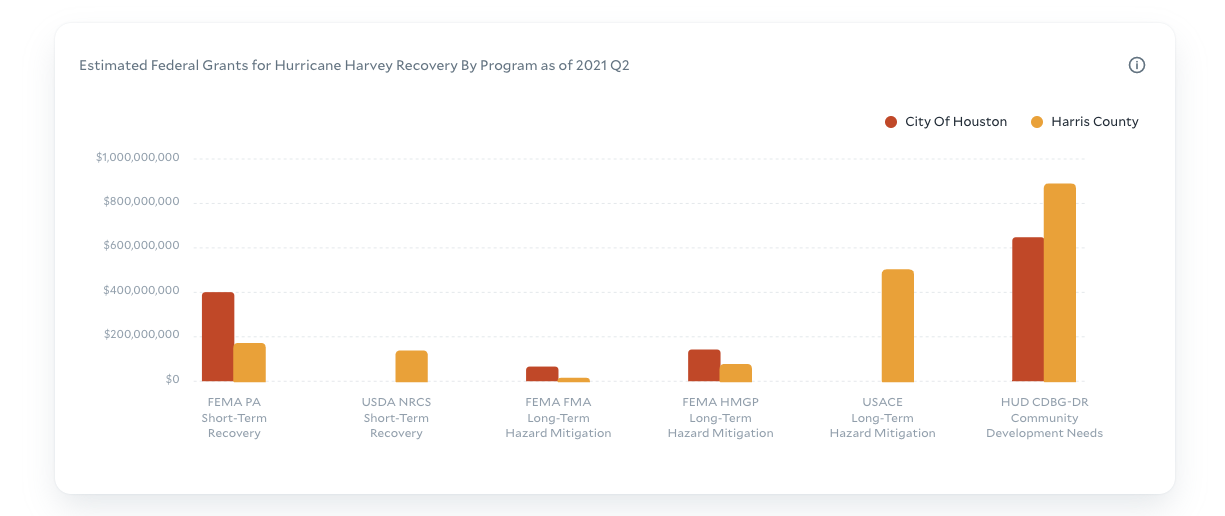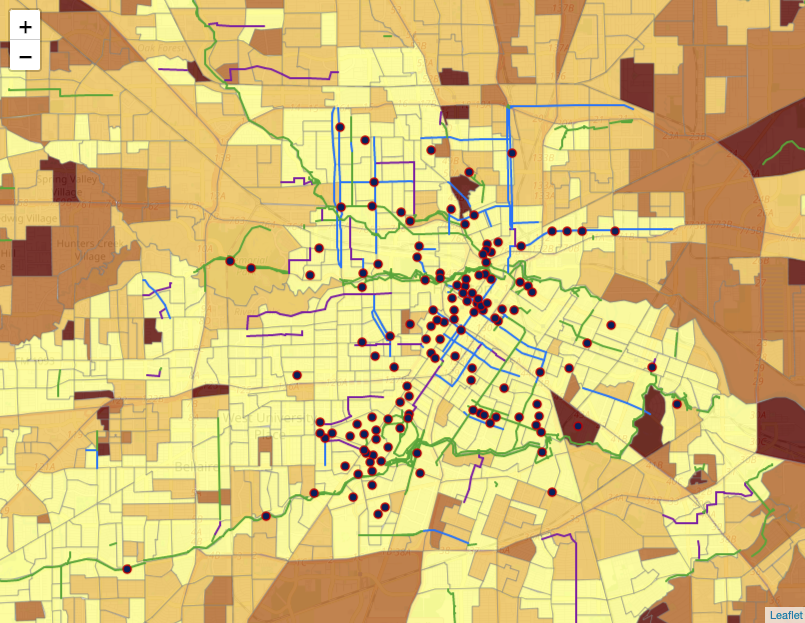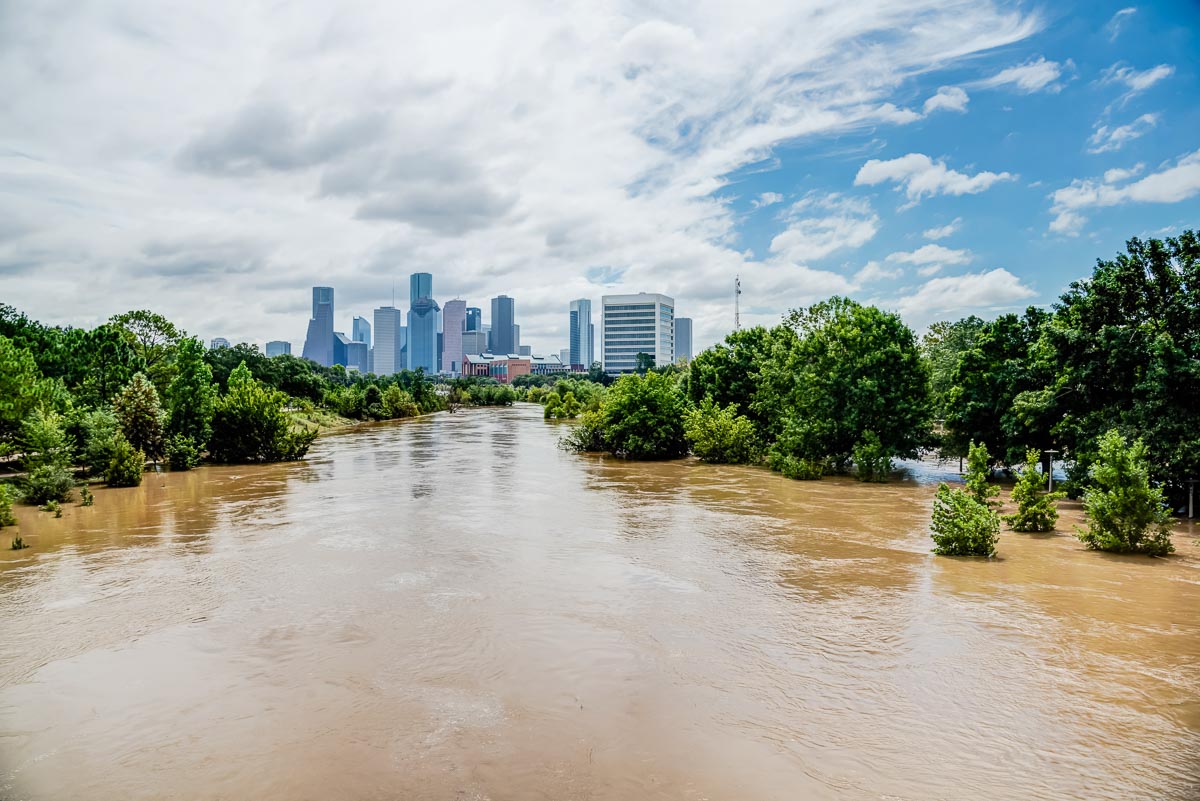The tracker consolidates information across multiple local government agencies and federal funding sources to provide some transparency and accountability to the often opaque and rapidly changing disaster recovery process and to Houston’s progress toward its climate and resilience goals that were announced in 2020.
It is clear the city and county are making progress in several key areas but also face mounting challenges on all fronts, from navigating disaster recovery aid allocations to reducing pedestrian deaths. With the tracker now open to the public, we can see where we stand as a community and have critical conversations about how to move forward.

A snapshot of disaster recovery funding sources. Click the chart to access a detailed view on the Resilience and Recovery Tracker.
The platform’s Hurricane Harvey Funding Dashboard visualizes $3 billion in federal disaster recovery funding from five agencies to make it more accessible and understandable to Houston and Harris County residents. The dashboard tracks federal grant funding and expenditures related to housing, infrastructure and economic development for the two largest subrecipients of federal funds in the region—Harris County and the City of Houston.
These funds provide local jurisdictions with the opportunity to transform hard-hit communities, improve infrastructure and safeguard the region against future disasters. The dashboard will be updated quarterly and is organized around three disaster recovery stages—short-term recovery, long-term hazard mitigation and community development.
The dashboard includes funding allocations toward property buyouts (a combined $430 million in the city and county) as well as major mitigation projects, such as the North Canal, Brays Bayou and Clear Creek. The funding data also calls attention to the slow, deliberate nature of disaster recovery spending, such as the fact that only $134 million in Community Development Block Grant funds have been spent on housing through mid-2021, out of a commitment of over $1.1 billion. Spending data does not always reflect the full scope of efforts that are planned and in various stages of implementation, while other spending items may be awaiting federal reimbursement, delaying a full picture of the extent of spending activities occurring on the ground.
The dashboard does not include the Harris County Flood Control District’s $2.5 billion bond, nor the Community Development Block Grant Mitigation program funds that are currently the subject of a federal ruling over racial discrimination.
The Climate and Resilience Metrics section of the tracker provides an annual snapshot measuring progress toward the City of Houston’s goals on urban resilience and climate change.
This includes the targets set by Resilient Houston, which aims to adapt the city’s infrastructure, institutions, and communities to better withstand the major shocks and chronic stresses in a rapidly changing world. This strategy couples existing efforts with new ones to collectively protect Houston from future natural disasters and chronic stresses such as aging infrastructure, poor air quality and flooding. It also includes progress on the city’s Climate Action Plan, which is organized around four focus areas in the city’s effort to mitigate the effects of climate change—transportation, energy transition, building optimization and materials management.
Across these metrics, the tracker helps identify areas of progress and challenge—three steps forward, two steps back, in some areas.
For example, Houston has excelled at planting trees in sufficient numbers—though we are not able to identify whether they are planted equitably—and is on track to meet its goal of 4.6 million plantings by 2030. It is also succeeding in building out its high-comfort bike network, with 92 miles added in 2021. The city is also ahead of schedule in its efforts to expand the use of green stormwater infrastructure, with 40 projects permitted last year alone.

Houston's existing and proposed bike infrastructure. Click the map to access a detailed view on the Resilience and Recovery Tracker.
But the city faces critical challenges in meeting big goals, such as reducing traffic-related fatalities, which outpaced the national trend in 2021, and reducing single-occupancy car dependency (as measured by vehicle miles traveled, or VMT), which increased despite the prolonged pandemic. The city is also trending in the wrong direction on diverting residential solid waste, and it needs to see much wider adoption of solar power to meet its target.
The Resilience and Recovery Tracker offers one way to provide accountability as local leaders chart out a more resilient future. While our efforts help to organize hard-to-reach information for the public, it remains short of illustrating the entire catalog of data tied to disaster recovery due to the massive undertaking required.
Even so, there is an emerging picture of how progress and innovation is strengthening communities in ways previously overlooked within the Houston region. In that sense, the tracker is a reflection of how far we’ve come and where we continue to struggle.
The platform was designed for wide public use, and we welcome feedback for ways to improve it. Send comments or suggestions to kinder@rice.edu.
The Kinder Institute for Urban Research thanks Chevron for its financial contribution to be able to put together the Resilience and Recovery Tracker. Special thanks to numerous Harris County departments and the Harris County Flood Control District for partnering and sharing disaster recovery data, in addition to the City of Houston’s Office of Resilience and Sustainability for collaborating with resilience and climate action metrics. It is our hope that their commitment to transparency and accountability become standard practice across all governmental agencies in future plans and initiatives of regional significance.

